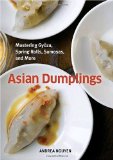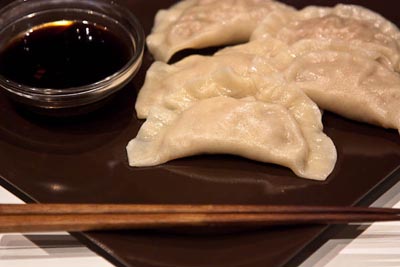I love dumplings. I don’t mean chicken and dumplings (though I love those dumplings too). I mean beautiful little meat or vegetable stuffed Asian dumplings that have been perfectly steamed or pan fried and are usually served with an extremely flavorful sauce. Andrea Nguyen’s new book, Asian Dumplings, makes these little bundles of goodness accessible to enthusiastic home cooks as well.



One of my favorite surprises was located in the equipment section. Ms. Nguyen notes that you should get a smallish dowel-type rolling pin for rolling out the wrappers (and she’s most certainly correct – being the stubborn patoot that I am, I had to try it the hard way first with a regular rolling pin – spend the three dollars and buy the little rolling pin - or better yet, make one yourself). While traditionally the wrappers are rolled completely by hand, she recommends using a tortilla press (pictured below) to initially flatten out the dough. Not your normal piece of Asian cookware, to be sure, but genius nonetheless. I’ve tried making my own wrappers before only to get annoyed and buy off-the-shelf gyoza skins or wonton wrappers instead. With her clear and very detailed instructions (and the tortilla press and a little dowel rolling pin), I was busting out wrappers like nobody’s business. And get this – they’re easier to work with than the packaged wrappers. And they’re so soft and tender compared to the store-bought ones. Am I gushing? I think I’m gushing.
The recipes are organized in a progressive manner, starting with very simple thick flour and water wrapper-wrapped dumplings and moving to more difficult techniques as one works through the book. The emphasis seems to be on flexibility. Don’t want to make wrappers? There are tips for using the ones from the store. Not good with crimping and forming elaborate shapes? No problem, there are several different ways to form a dumpling, and more often than not, they can be substituted. Shaped dumplings looking rather forlorn? Doesn’t matter, they’ll still taste good.
Admittedly, I’m not the foremost authority on these matters, but Asian Dumplings (as the title implies) seems to do a wonderful job of including dumpling recipes that extend well beyond the familiar Chinese pot stickers. India and much of Southeast Asia appears to be very well represented in the pages of this text.
Often it is easier to be shown how to do something than to be told. Particularly for the rolling of the dough and stuffing, and forming of the dumplings, illustrations are included to help demystify the process. The end results of many of the book’s recipes are also gorgeously photographed (by Austin’s own Penny de los Santos, no less) so you can see how close you managed to get once your creations are completed. Also, for further information, you can visit Andrea Nguyen’s site: asiandumplingtips.com.

My first attempt at making dumplings from this book was the very first recipe: Pork and Napa Cabbage Water Dumplings. On the first day, I made the chile oil, sauce, and the filling (which didn’t take very long at all) and the next, made the dough and the dumplings (which took longer than I care to admit). I froze half and made the other half for our dinner that evening. They were delicious. Rich, flavorful pork was encased in the supple homemade wrappers. The tangy, chile-tinged sauce was the perfect accompaniment to the fatty pork. The frozen ones reheated well, though to be fair, I don’t think they spent more than three or four days in our freezer before we felt compelled to eat them. I’m looking forward to trying more recipes from this book in the not-too-distant future.
Asian Dumplings is a book I would highly recommend to anyone who enjoys this sort of food. It is an excellent teaching text – very little is left to question in the explanations and instructions. And if you follow those instructions, I expect you’ll be very pleased with the results.

